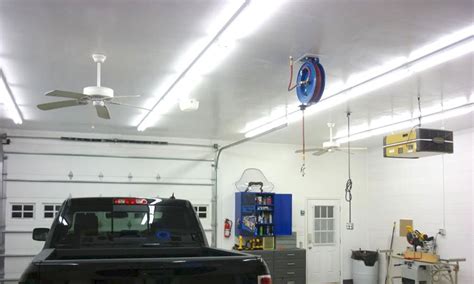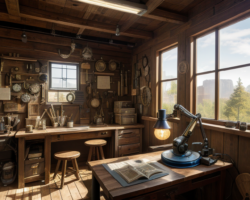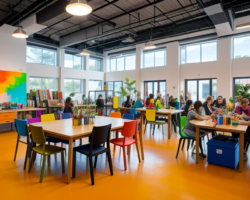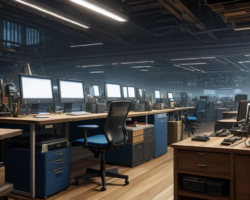When it comes to creating a well-designed and functional space, lighting is often an essential element that is overlooked. Whether you’re renovating your home or revamping your office, it’s crucial to assess your lighting needs and understand the different types of lighting available. From calculating the optimal lighting level to choosing the right fixture style, there are various factors to consider. In this blog post, we will guide you through the process of creating a balanced lighting design by exploring task-specific solutions, determining the best fixture placement, and delving into energy-efficient options. Let’s shed some light on the subject and transform your space into a beautifully illuminated haven.
Assessing your lighting needs
Assessing Your Lighting Needs
When it comes to lighting your home or workspace, it’s important to assess your lighting needs to ensure that you have the right type and level of illumination. By doing so, you can create a comfortable and functional space that meets your specific requirements. Assessing your lighting needs involves considering factors such as the purpose of the space, the activities that will be carried out, and the natural light available.
One key aspect to assess is the purpose of the space. Different areas in your home or office may have different lighting needs. For example, a kitchen may require brighter and task-oriented lighting for food preparation, while a living room may benefit from softer and more ambient lighting for relaxation and socializing. By identifying the purpose of each space, you can determine the type of lighting solution that will best suit your needs.
Another factor to consider when assessing your lighting needs is the activities that will take place in the space. If you have a home office, for instance, you may need focused lighting for reading, writing, or working on a computer. On the other hand, if you have a dining area, you may want to create a more intimate atmosphere with dimmable lights for entertaining guests. By understanding the specific activities that will occur in each area, you can choose lighting fixtures and bulbs that will support those activities effectively.
Natural light also plays a crucial role in assessing your lighting needs. Take note of the amount of sunlight that enters each space throughout the day. If you have plenty of natural light, you may be able to rely on it for most of the day and only require artificial lighting during the evening or in certain areas of the room. On the other hand, if your space is poorly lit naturally, you may need to invest in brighter or differently positioned fixtures to compensate for the lack of daylight.
- Consider the purpose of each space
- Identify the specific activities that will take place
- Take into account the amount of natural light available
| Purpose of Space | Specific Activities | Natural Light |
|---|---|---|
| Kitchen | Food preparation | Good amount during the day |
| Living room | Relaxation, socializing | Moderate amount during the day |
| Home office | Reading, computer work | Varies; may require artificial lighting |
| Dining area | Entertaining guests | Moderate amount during the day |
In conclusion, assessing your lighting needs is a crucial step in creating a well-designed and functional space. By considering the purpose of each area, the specific activities that will occur, and the amount of natural light available, you can determine the optimal lighting solution for your needs. Whether it’s task-specific lighting, ambient lighting, or a combination of both, taking the time to assess your lighting needs ensures that you can enjoy a comfortable environment that meets your requirements.
Understanding different types of lighting
The world of lighting can be quite complex, with a wide variety of options available to illuminate your space. Understanding the different types of lighting can help you make informed decisions when it comes to choosing the right fixtures for your needs. In this article, we will explore the various types of lighting and their unique characteristics.
1. Ambient Lighting: Also known as general lighting, ambient lighting provides overall illumination to a space. It is the foundation of any lighting design and ensures a comfortable level of brightness throughout the room. Examples of ambient lighting include ceiling-mounted fixtures, recessed lights, and chandeliers.
2. Task Lighting: Task lighting is focused on specific areas where activities such as reading, cooking, or working take place. This type of lighting ensures sufficient brightness for performing tasks without straining the eyes. Table lamps, under-cabinet lights, and desk lamps are common examples of task lighting.
3. Accent Lighting: Accent lighting is used to highlight particular objects, architectural features, or artwork in a room. It adds depth and visual interest to the space by creating focal points. Track lighting, recessed spotlights, and picture lights are commonly used for accent lighting.
4. Decorative Lighting: As the name suggests, decorative lighting serves as a decorative element in a room. It adds aesthetic appeal and can make a statement in terms of design. Examples of decorative lighting include pendant lights, sconces, and elaborate chandeliers.
5. Natural Lighting: While not a type of artificial lighting, natural lighting plays a significant role in any lighting design. It utilizes daylight to illuminate a space, creating a connection with the outdoors and promoting a sense of well-being. Maximizing natural light can help reduce energy consumption and create a more inviting atmosphere.
Understanding the different types of lighting allows you to create a well-balanced and functional lighting design for your space. By combining various types of lighting, you can achieve the desired ambiance and meet your specific lighting needs. So, don’t be afraid to mix and match different lighting fixtures to create a visually appealing and practical lighting scheme in your home or workspace!
Calculating the optimal lighting level
When it comes to lighting, it’s not just about having enough light in a space; it’s also about having the optimal lighting level for your specific needs. Calculating the right lighting level requires taking into consideration several factors, such as the function of the space, the activities that will be performed, and the overall design aesthetic.
One way to determine the optimal lighting level is by considering the recommended illuminance levels for different areas or tasks. Illuminance, measured in lux, refers to the amount of light that falls onto a surface. For example, a living room or bedroom typically requires an illuminance level of around 150-250 lux, while a kitchen or office space may require a higher level of around 500-750 lux. These recommendations can serve as a starting point in calculating the optimal lighting level for your space.
Another important factor to consider is the color temperature of the light. Color temperature is measured in Kelvin and refers to the appearance of the light, whether it appears warm or cool. Warm light, with a lower color temperature (around 2700-3000K), creates a cozy and inviting atmosphere, while cool light, with a higher color temperature (around 4000-5000K), is often used in workspaces or areas that require better visual acuity. Finding the right balance between warm and cool light can contribute to achieving the optimal lighting level.
- Ambient lighting: Also known as general lighting, ambient lighting provides overall illumination to a space. This can include ceiling fixtures, chandeliers, or recessed lighting.
- Task lighting: Task lighting is specifically designed to provide focused light for performing specific tasks or activities, such as reading, cooking, or working on a computer. It can include desk lamps, under-cabinet lighting, or adjustable track lighting.
- Accent lighting: Accent lighting is used to highlight specific objects or areas in a space, such as artwork, sculptures, or architectural features. It can include track lighting, wall sconces, or picture lights.
Once you have determined the recommended illuminance levels and selected the appropriate lighting fixtures, it’s important to consider the placement and distribution of the fixtures to ensure an even and balanced lighting design. For example, placing fixtures too close together can create glare or shadows, while spacing them too far apart can result in dark spots. Experimenting with different placements and configurations can help you achieve the optimal lighting level for your space.
| Space | Recommended Illuminance Level (lux) |
|---|---|
| Living Room | 150-250 |
| Kitchen | 500-750 |
| Office | 500-750 |
In conclusion, calculating the optimal lighting level involves considering the recommended illuminance levels, color temperature, and the function of the space. By selecting the appropriate lighting fixtures and ensuring their proper placement, you can create a well-lit and visually appealing environment that meets your specific lighting needs.
Choosing the right fixture style
Choosing the right fixture style is an important aspect when it comes to creating the perfect lighting design for your space. The type of fixtures you choose can have a significant impact on the overall ambiance and functionality of the room. There are several factors to consider when selecting the right fixture style, such as the room’s decor, the purpose of the lighting, and personal preferences.
When choosing a fixture style, it is essential to consider the overall theme and decor of the room. You want the lighting fixtures to complement the existing design elements and enhance the overall aesthetic. For example, if you have a modern and minimalistic interior, you may opt for sleek and minimalist fixtures with clean lines and minimal ornamentation. On the other hand, if your room has a more traditional or vintage style, you might prefer fixtures with more intricate details and a classic design.
Another crucial factor to consider when selecting a fixture style is the purpose of the lighting. Different areas of your space may require specific types of lighting, such as task lighting for a home office or ambient lighting for a living room. Task-specific fixtures, such as adjustable desk lamps or pendant lights, can provide focused lighting for activities that require more brightness and precision. On the other hand, ambient fixtures, such as chandeliers or recessed lights, can create a softer and more relaxed atmosphere for general lighting purposes.
- Consider the room’s decor and theme
- Assess the purpose of the lighting
- Take personal preferences into account
Personal preferences also play a significant role in choosing a fixture style. The lighting fixtures you choose should resonate with your personal taste and style. Take some time to explore various options and consider what appeals to you the most. Do you prefer modern and sleek fixtures, or do you lean towards more traditional and ornate designs? Take into account the overall style and vibe you want to achieve in your space.
In conclusion, choosing the right fixture style is a crucial step in creating a well-designed lighting plan. Consider the room’s decor, the purpose of the lighting, and your personal preferences to select fixtures that not only provide the right level of illumination but also add to the overall aesthetic of the space. By taking these factors into account, you can ensure that your lighting design is not only functional but also visually appealing.
Considering energy efficiency options
When it comes to lighting up our spaces, it’s important to not only think about the aesthetics but also consider the energy efficiency of our choices. With the growing concern for the environment and the rising energy costs, finding energy-efficient lighting options has become crucial. By opting for energy-efficient lighting, not only can we lower our electricity bills, but we can also reduce our carbon footprint on the planet. In this blog post, we will explore various energy efficiency options that you can consider for your lighting needs.
One of the most popular energy-efficient options available today is the use of LED (Light Emitting Diode) lighting. LED lights are known for their long lifespan, consuming less energy compared to traditional incandescent or fluorescent bulbs. They are highly efficient as they convert most of the energy into light rather than heat. Additionally, LED lights are available in a variety of styles and colors, allowing you to easily find the right lighting solution for your space.
Another energy-efficient lighting option to consider is the use of compact fluorescent lamps (CFLs). CFLs are known for their high energy efficiency and longevity. They use around 75% less energy than incandescent bulbs and can last up to 10 times longer. CFLs come in different shapes and sizes, making them suitable for various fixtures and settings. However, it’s important to note that CFLs contain a small amount of mercury, so proper disposal is necessary to ensure environmental safety.
Aside from LED and CFL options, you can also explore the use of motion sensors and dimmers to enhance energy efficiency. Motion sensors can automatically turn off lights when no one is present in the room, saving energy by avoiding unnecessary lighting. Dimmers, on the other hand, allow you to adjust the brightness of the lights according to your needs, reducing energy consumption and creating a cozy ambiance.
- LED lights: Long lifespan and high energy efficiency.
- Compact fluorescent lamps (CFLs): Energy-efficient and last up to 10 times longer.
- Motion sensors: Automatically turn off lights when not in use.
- Dimmers: Adjust brightness and create a cozy ambiance.
| Energy-Efficient Option | Benefits |
|---|---|
| LED lights | Long lifespan and high energy efficiency. |
| Compact fluorescent lamps (CFLs) | Energy-efficient and last up to 10 times longer. |
| Motion sensors | Automatically turn off lights when not in use. |
| Dimmers | Adjust brightness and create a cozy ambiance. |
By considering these energy efficiency options, you can not only minimize your energy consumption but also contribute to a greener and more sustainable future. Make a conscious choice when selecting lighting fixtures and explore the different options available in the market. Remember, a well-lit space doesn’t have to come at the cost of excessive energy usage!
Exploring task-specific lighting solutions
When designing a lighting scheme for your space, it is important to consider the different tasks that will be performed in each area. Task-specific lighting solutions can greatly enhance productivity and functionality in various settings, such as offices, kitchens, and workstations. By providing focused and targeted illumination, these lighting solutions aim to optimize visibility and minimize eye strain. This blog post explores some popular task-specific lighting solutions and how they can enhance different environments.
One common task-specific lighting solution is under-cabinet lighting in kitchens. This type of lighting is installed beneath cabinets to provide direct illumination onto countertops, making it easier to complete food preparation tasks. Under-cabinet lights are typically low-profile and energy-efficient, and they can be either hardwired or plug-in. The use of LED lights in under-cabinet lighting has become increasingly popular due to their long lifespan, energy efficiency, and ability to produce bright and focused light.
Another task-specific lighting solution is task lamps in office or study areas. Task lamps are designed to provide direct lighting onto the task at hand, such as reading, writing, or working on a computer. They are usually adjustable and portable, allowing users to position the light exactly where they need it. Task lamps can help reduce eye strain and improve concentration by illuminating the specific area where the task is being performed, while minimizing glare and shadows.
- Desk lamps: These are the most common type of task lamps used in offices or study areas. They usually have a flexible arm or adjustable head to direct the light precisely onto the desk or work surface.
- Clip-on lamps: These lamps can be attached to the edge of a desk or bookshelf, providing focused lighting without occupying valuable desk space.
- Architect lamps: These lamps have a modern and sleek design, typically featuring a long adjustable arm and a heavy base for stability. They are popular among architects, artists, and designers.
In addition to under-cabinet lighting and task lamps, picture lights are another task-specific lighting solution often used to highlight artwork or decorative features. Picture lights are usually mounted on the wall or ceiling, above the artwork, directing a focused beam of light onto the piece. This type of lighting not only enhances the aesthetic appeal of the artwork but also provides sufficient illumination for viewing and appreciation.
| Type of Lighting Solution | Primary Area of Application |
|---|---|
| Under-cabinet lighting | Kitchens |
| Task lamps | Offices and study areas |
| Picture lights | Art galleries and residential spaces |
By exploring and implementing task-specific lighting solutions, you can significantly improve the functionality and efficiency of different spaces. Whether it’s enhancing visibility in your kitchen, providing optimal lighting for work or study, or highlighting artwork, the right task-specific lighting solution can make a noticeable difference. Consider your specific needs and preferences, and consult with lighting professionals to select the most suitable lighting fixtures for your tasks and environment.
Determining the best placement for fixtures
Determining the best placement for fixtures is a crucial aspect of creating a well-designed and functional lighting scheme. Whether you’re setting up lighting for your home, office, or any other space, proper fixture placement can make a significant difference in enhancing the overall ambiance and functionality. By strategically positioning fixtures, you can ensure that light is distributed evenly and effectively throughout the room. In this article, we will explore some key considerations for determining the best placement for fixtures to help you achieve an optimal lighting design.
1. Room Functionality: The first step in determining fixture placement is understanding the intended functionality of the room. Different areas within a space may have specific lighting requirements. For instance, in a kitchen, task lighting is crucial over countertops and cooking areas, while ambient lighting may be more important in a living room. Identify the different functions of the room and prioritize lighting accordingly.
2. Lighting Layers: It’s essential to incorporate different layers of lighting to create depth and visual interest in a room. These layers typically include ambient, task, and accent lighting. When determining fixture placement, consider the type of lighting layer each fixture will contribute to. For example, recessed ceiling lights can provide ambient lighting, while wall sconces or pendant lights can offer task or accent lighting. Distribute fixtures across the room to ensure all lighting layers are adequately covered.
3. Room Layout and Size: The layout and size of the room play a significant role in fixture placement. Take into account the dimensions of the room, including ceiling height, wall positions, and furniture layout. Avoid placing fixtures too close to walls or furniture, as this can create undesirable shadows or glare. Aim for even illumination across the entire space by placing fixtures strategically in areas that require adequate lighting.
In conclusion, determining the best placement for fixtures requires careful consideration of room functionality, lighting layers, and room layout. By incorporating different types of lighting and distributing fixtures effectively, you can create a balanced lighting design that enhances both the aesthetics and functionality of the room.
Remember, lighting is not only about providing sufficient illumination but also about creating the right atmosphere and mood. Take the time to assess your lighting needs and experiment with different fixture placements to find the optimal arrangement for your space. With proper fixture placement, you can transform any room into a well-lit and inviting environment.
Creating a balanced lighting design
When it comes to designing the lighting for your space, it’s important to consider how each element of lighting contributes to the overall balance of the room. Whether you’re designing the lighting for a home or a commercial space, a balanced lighting design can make a significant difference in the ambiance and functionality of the space. In this blog post, we will explore the key factors to consider when creating a balanced lighting design.
1. Assessing your lighting needs: Before you start designing the lighting for your space, it’s important to assess your specific lighting needs. Consider the purpose of the room and the activities that will take place in it. Different areas may require different types and levels of lighting. Once you have a clear understanding of your lighting needs, you can begin to plan a balanced lighting design.
2. Understanding different types of lighting: To create a balanced lighting design, it’s essential to understand the different types of lighting available. There are three main types of lighting: ambient, task, and accent. Ambient lighting provides overall illumination and sets the mood of the room. Task lighting is focused lighting that illuminates specific work areas. Accent lighting is used to highlight architectural features or artwork. By incorporating all three types of lighting, you can achieve a balanced and layered lighting design.
3. Calculating the optimal lighting level: Another important factor in creating a balanced lighting design is determining the optimal lighting level for each area of the space. The lighting level depends on the activities that will take place in the area. For example, a kitchen may require brighter task lighting for food preparation, while a bedroom may require softer ambient lighting for relaxation. By calculating the optimal lighting level for each area, you can ensure that the lighting is both functional and visually pleasing.
Creating a balanced lighting design involves considering all aspects of lighting, from assessing your lighting needs to understanding different types of lighting and calculating the optimal lighting level. By carefully planning and designing the lighting for your space, you can create a balanced and inviting atmosphere that enhances both the functionality and aesthetics of the room.
Frequently Asked Questions
1. What factors should I consider when assessing my lighting needs?
When assessing your lighting needs, you should consider factors such as the purpose of the space, the desired ambiance, the activities that will take place in the area, and any specific lighting requirements.
2. What are the different types of lighting and when are they most suitable?
There are three main types of lighting: ambient, task, and accent lighting. Ambient lighting provides overall illumination for a room, task lighting is focused on specific activities, and accent lighting highlights architectural features or decorative elements.
3. How do I calculate the optimal lighting level for a space?
The optimal lighting level depends on the function of the space. As a general rule, task areas require higher light levels than living spaces. You can use a light meter or consult lighting standards to determine the recommended illumination levels for different areas.
4. What factors should I consider when choosing the right fixture style?
When choosing a fixture style, factors such as the overall design aesthetic, the size and scale of the space, and the intended use of the lighting should be considered. Additionally, the fixture should complement the decor and serve as a visually appealing element in the room.
5. What are some energy efficiency options to consider for lighting?
Some energy efficiency options for lighting include using LED bulbs instead of traditional incandescent bulbs, installing dimmer switches to adjust light levels, and using motion sensors or timers to control lighting usage. Additionally, choosing fixtures with high energy efficiency ratings can help reduce energy consumption.
6. Are there task-specific lighting solutions available?
Yes, there are task-specific lighting solutions available for various activities such as reading, cooking, and working. For example, adjustable desk lamps, under-cabinet lighting in kitchens, and wall-mounted reading lights are all examples of task-specific lighting solutions.
7. How can I determine the best placement for lighting fixtures?
The best placement for lighting fixtures depends on the function of the space and the desired lighting effect. Generally, fixtures should be evenly distributed to avoid shadows and provide consistent illumination. It is important to consider the height, angle, and direction of light when determining the placement of fixtures.





